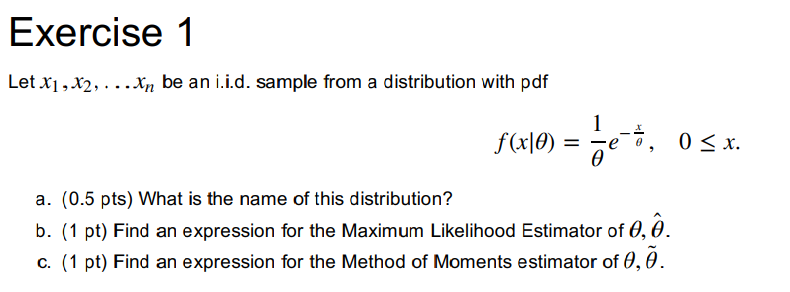
"Exponential distribution - Maximum Likelihood Estimation", Lectures on probability theory and mathematical statistics. Parameters of the following distributions and models. StatLect has several pages like this one. =TRIMMEAN(R1.76) where R1 contains the sample values.This means that the distribution of the maximum likelihood estimatorĬan be approximated by a normal distribution with mean A better estimate for µ is the mean of the middle 24% of the sample i.e. A related approach is to estimate the µ parameter by the median and the σ parameter by half the interquartile range of the sample. Since the mean and standard deviation of the Cauchy distribution are undefined, these cannot be used to estimate the distribution’s parameters. The Laplace distribution parameters can be estimated by μ = x̄ and β = s/√2. The Logistic distribution parameters are estimated by μ = x̄ and β = s√3/ π. The Gumbel distribution parameters can be estimated by β = s√6/ π and μ = x̄ – βγ where γ is the Euler-Mascheroni constant with a value approximately equal to. The geometric distribution parameter can be estimated as p = 1/(1– x̄). The gamma distribution parameters can be calculated as β = s 2/ x̄ and α = x̄/ β. We briefly describe different frequentist methods of estimation approaches, namely, maximum likelihood estimators, moments estimators, L-moment estimators. Similarly, the lambda parameter for the Poisson distribution can be estimated by the sample mean. For example, the parameters for the normal distribution can be estimated by the sample mean and standard deviation. Many of the distributions we have studied on this website can be handled as for the exponential distribution described above. Generalized Extreme Value (GEV) Distribution.Note too that when we use s 2 in the following examples, we should technically replace s 2 by ( n–1) s 2/ n to get t 2. We use maximum likelihood estimation (MLE) method as a part of frequentist methodology for. s 2 is implemented in Excel via the VAR.S function. nentiated moment exponential distribution, Bayes estimator. For normal distribution, we have Var(X) 2 V a r ( X) 2, so 2 2 should be 1 n (Xi X¯)2 1 n ( X i X ¯) 2, but.

This is not technically the method of moments approach, but it will often serve our purposes. Yes, 1 n1 n i1(Xi X¯)2 1 n 1 i 1 n ( X i X ¯) 2 does not be a method of moments estimation. Since often our samples are small, we will tend to use the sample variance s 2, which is an unbiased, consistent estimator, instead of σ 2.

Population Varianceįrom Estimators, we know that t 2 is a biased estimator, but as the sample size gets larger, t 2 becomes (asymptotically) unbiased and consistent. x̄ and t 2 are implemented in Excel via the AVERAGE and VAR.P functions, respectively. We will use the sample mean x̄ as our estimator for the population mean μ and the statistic t 2 defined byĪs an estimator for the population variance σ 2. In the method of moments approach, we use facts about the relationship between distribution parameters of interest and related statistics that can be estimated from a sample (especially the mean and variance).

Elsewhere we will describe two other such methods: maximum likelihood method and regression. We now describe one method for doing this, the method of moments.

Given a collection of data that we believe fits a particular distribution, we would like to estimate the parameters which best fit the data.


 0 kommentar(er)
0 kommentar(er)
